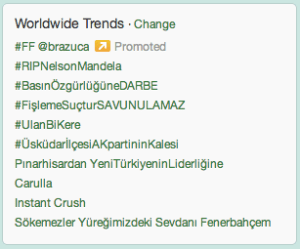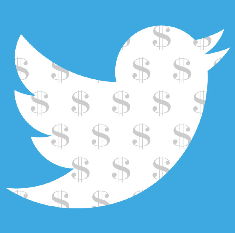Twitter has been putting a lot of effort into its advertising business, which today is the newly public company’s primary strategy for generating revenue. But it turns out that one of its earliest, lean-back efforts has not proven to be its most fruitful: Promoted Trends generated less than 10 percent of the company’s revenue in the three months ended June 30, 2013.
The detail comes by way of correspondence between Twitter and the SEC, made in the weeks leading up to its first public S-1 report on October 3 ahead of its November IPO. The social networking startup had initially made a private filing with the SEC, courtesy of the JOBS Act, which lets companies with revenues of less than $1 billion file without immediately exposing details of its finances. (Twitter says in its S-1 that revenues for the first nine months in 2013 were $422.2 million.)
Specifically, the SEC requested Twitter to modify its revenue graphs to include “number of ad engagements per 1,000 timeline views” and “revenue per ad engagement” notations, and to additionally specify any other revenue sources that do not require user engagement.
In its response, Twitter notes the following in correspondence from September 6:
The Company respectfully advises the Staff that, in the three months ended June 30, 2013, less than 10% of its revenue was generated from its Promoted Trends product, which is the only Promoted Product for which revenue is recognized on a fixed-fee basis and does not require any user engagement. The Company does not believe that Promoted Trends will have a material impact on the metrics disclosed in the Registration Statement in the future.
 Promoted Trends, first revealed in 2010, were a follow-on from the Promoted Tweets that appeared in users’ Timelines. Promoted Trends were one of the company’s first attempts at using an area outside of the Timeline to drive revenues. In February, the price for Promoted Trends was around the $200,000 mark, AllThingsD reported at the time.
Promoted Trends, first revealed in 2010, were a follow-on from the Promoted Tweets that appeared in users’ Timelines. Promoted Trends were one of the company’s first attempts at using an area outside of the Timeline to drive revenues. In February, the price for Promoted Trends was around the $200,000 mark, AllThingsD reported at the time.
In September of this year, Twitter gave Promoted Trends a little promotion of their own, with fuzzy metrics touting how they “produced 22% more conversations about an advertiser,” gave a 30% lift in brand mentions, and a 32% lift in retweets of brand mentions in the first two weeks of exposure.
But, it seems that even with all that, off-piste has remained a marginal product, the runt of the litter to Promoted Tweets and Promoted Accounts. That may also partly explain why Twitter has instead opted to focus on ways of delivering promotions within users’ Timeline streams instead, and continues ramping up with new products, such as the retargeting product announced this week.
The letters between Twitter and the SEC, now listed in Twitter’s public filings, for the most part contain questions about certain details in Twitter’s S-1, with Twitter’s subsequent edits. (“The Company respectfully advises the Staff that it has revised the disclosure on page XX to address the Staff’s comment” appears a lot.) But there are also a few other interesting details in the notes that never seem to have made their way into the S-1 filing.
Another one that caught my eye was about Sina Weibo. In an August letter, the SEC asks Twitter to explain better why Sina Weibo is considered a competitor. This longer explanation, which details Twitter’s concern with Sina Weibo’s international ambitions, also hasn’t quite made it into the S-1 filing we see today (bolding mine):
“The Company respectfully advises the Staff that there are a number of reasons it considers Sina Weibo a competitor even though the Company is not permitted to operate in China,” Twitter writes. “Sina Weibo attempts to offer products and services that are somewhat similar to those offered by the Company, and Sina Weibo has started to offer its products and services outside of China and may continue such expansion outside of China. As such, outside of China, the Company has started to compete directly with Sina Weibo, and expects this competition to continue to grow in the future.
“In addition, Sina Weibo has grown rapidly in China, and has a significant user base and a substantial amount of content on its platform. The Company operates a global platform, and if content is available on Sina Weibo and it cannot be accessed on the Company’s platform, it may reduce the Company’s ability to attract users to its platform.
“Further, the Company may eventually be permitted to operate in China. If the Company were ultimately able to operate in China, it would face significant challenges in gaining users in China because Sina Weibo would already be an established and entrenched competitor.
“As such, the Company believes it is appropriate to list Sina Weibo as a competitor in the Registration Statement.”
What’s also interesting here is that neither the SEC nor Twitter mention Line and Kakao, two other social networking products popular in Asia that do find their way into the S-1. Whether those were later additions, or whether the SEC simply didn’t choose to pinpoint them in its question, is not clear. Although the S-1 only notes the challenges to entering a market like China, Twitter takes a slightly more frank and less guarded tone when communicating directly with the SEC.
(h/t to Zach Seward for first noticing the filings)
